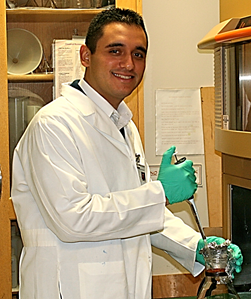
Eric Gonzalez, Ph.D.
Department: Biochemistry, 2017
Faculty Mentor: F. Peter Guengerich, Ph.D.
Dissertation Title: The Kinetic and Chemical Mechanisms of Human Cytochrome P450 17A1
Dissertation Abstract: Human cytochrome P450 (P450) 17A1 is an essential enzyme in the steroid biosynthesis pathway that mediates a critical branch point which leads to either glucocorticoid or sex hormone production. P450 17A1 is a bifunctional enzyme that catalyzes 17α-hydroxylation of pregnenolone and progesterone and subsequently a 17,20-lyase reaction that generates dehydroepiandrosterone and androstenedione, respectively. While the 17α-hydroxy steroids are substrates for the androgen generating cleavage reaction, they are also precursors to glucocorticoids. Selective inhibition of the 17,20-lyase reaction to reduce androgen levels, without disrupting glucocorticoid production, is a current goal in prostate cancer therapy. The objective of this investigation was to evaluate the chemical and kinetic mechanisms of human P450 17A1 that enable catalysis of two distinct reactions, with the purpose of contributing greater insight for the development of cleavage-selective inhibitors. The chemical mechanism of the 17,20-lyase reaction was assessed and the results provide compelling support for a Compound I-mediated mechanism but have not ruled out a ferric peroxide mechanism. Novel hydroxylation products were identified in the course of these studies. The majority of the new products were 16-hydroxy steroids and, remarkably, hydroxylation of a B-ring carbon was also observed (6β,16α,17α-trihydroxyprogesterone). One critical factor for reaction-selective inhibition of P450 17A1 is the processivity in catalyzing the sequential reactions. The kinetic mechanism of human P450 17A1 was evaluated using steady-state and pre-steady-state methods, and a minimal kinetic model was developed using KinTek Explorer® software. Human P450 17A1 was primarily distributive in catalyzing the two reactions but was more processive with pregnenolone than with progesterone. Furthermore, cytochrome b5 (b5) enhanced the processivity and the results indicate that it functions as a shunt towards sex hormone production. A theoretical model was proposed that includes multiple enzyme conformations, including a more efficient, processive conformation that may be stabilized by b5. As such, selective inhibition of the 17,20-lyase reaction is complicated by the propensity of human P450 17A1 to catalyze the sequential reactions processively when b5 is present, and it is possible that it may only be accomplished by disrupting the interactions between the two proteins.
